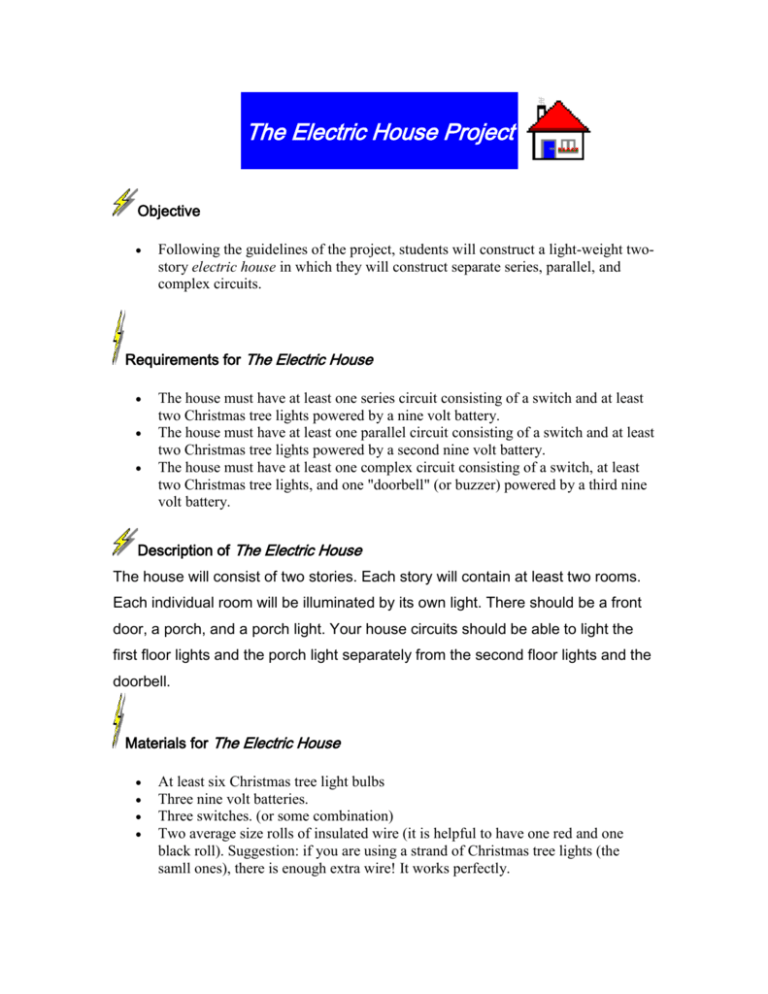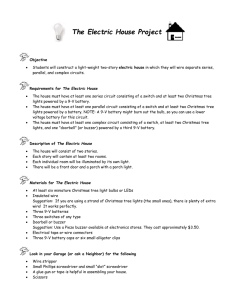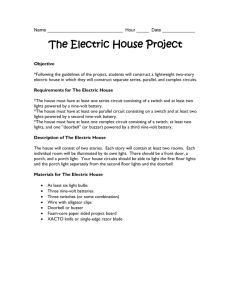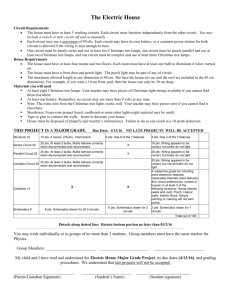The Electric House Project - Earl Haig Secondary School
advertisement

The Electric House Project Objective Following the guidelines of the project, students will construct a light-weight twostory electric house in which they will construct separate series, parallel, and complex circuits. Requirements for The Electric House The house must have at least one series circuit consisting of a switch and at least two Christmas tree lights powered by a nine volt battery. The house must have at least one parallel circuit consisting of a switch and at least two Christmas tree lights powered by a second nine volt battery. The house must have at least one complex circuit consisting of a switch, at least two Christmas tree lights, and one "doorbell" (or buzzer) powered by a third nine volt battery. Description of The Electric House The house will consist of two stories. Each story will contain at least two rooms. Each individual room will be illuminated by its own light. There should be a front door, a porch, and a porch light. Your house circuits should be able to light the first floor lights and the porch light separately from the second floor lights and the doorbell. Materials for The Electric House At least six Christmas tree light bulbs Three nine volt batteries. Three switches. (or some combination) Two average size rolls of insulated wire (it is helpful to have one red and one black roll). Suggestion: if you are using a strand of Christmas tree lights (the samll ones), there is enough extra wire! It works perfectly. Doorbell or buzzer. Suggestion: use a Piezo buzzer available at electronics stores. They cost approximately $3.00. Foam-core paper sided project board. Suggestion: Recycle your science fair tripanel. XACTO knife or single-edge razor blade. Scoring Rubric Group Project = 60 points 1. Meeting minimum construction requirements of two stories, four rooms, and a porch = 15 pts 2. Successfully meeting series circuit minimum requirements = 10 pts 3. Successfully meeting parallel circuit minimum requirements = 15 pts 4. Successfully meeting complex circuit minimum requirements = 20 pts 5. Bonus for creativity and/or ingenuity = 5 pts Individual Project = 40 points Each student will answer the following questions. You may submit your answers using the following form. Form to submit responses to questions Each question is worth eight points. Four points will be awarded for a correct response. Four points will be awarded for the appropriate supporting statements. In each of the questions, assume that the light bulbs have the same resistance. In each of your responses, describe what percentage of the current each light bulb originally carries. In each of your responses, describe how the described action will affect the intensities of the remaining lit light bulbs. All answers must be in complete sentences. 1. You have three light bulbs. All have the same intensity when lit. Explain how you can determine that they are connected in series by unscrewing one light bulb. Support your answer. 2. You have three light bulbs. All have the same intensity when lit. Explain how you can determine that they are connected in parallel by unscrewing one light bulb. In your response, state the relationship between the current and resistors in parallel. 3. You have three light bulbs. Two are connected in parallel. This parallel combination is connected in series with the third light bulb. Describe the relative intensity of each bulb. Support your answer. 4. In question number three, describe the relative intensities of the two remaining lit bulbs if one of the bulbs in parallel was unscrewed. Support your answer. 5. You have four light bulbs, light bulbs one, two, three, and four. All have the same intensity. Bulb one is unscrewed causing only bulb one to go out. Now, bulb two's intensity is 30% greater than it was originally. Bulbs three and four each have 2/3 of their original intensity. Based upon this information, how are the four bulbs wired? Support your answer. The Electric House Project Objective: Your team (maximum of 3 students) will design and construct an electric house with separate series, parallel, and complex circuits (contains both series and parallel circuits). The house will consist of one or two stories. Each house will contain at least the following areas: one bedroom, one bathroom, a kitchen, a porch, a front door, and a living room/dining room area. Each individual room will be illuminated by its own light. Materials: Your team will need the following materials toconstruct and wire the home the house frame, glue, additional tools, decorations, furniture and the batteries. Ten small light bulbs Seven switches Insulated wire Buzzer and button X-ACTO knife tri-fold foam board Project Timeline: The due date for this project is March 9th 2007 February 21- project handed out March 1st – all materials are brought in to classroom March 2nd to march 9th – project is worked on by all group members (Before School and during Lunch times) March 9th – Part I- final house project is due and Part II-Schematic diagrams and calculations are due. Requirements: - The house dimensions are approximately: 24" by 36" horizontally or vertically.( could be smaller). The tri-fold foam board is an excellent material for building the house or you can use wood. The House can be pre-built at home and bring to school to do the wiring. Each house will be wired with 5 different circuits as follows: - The living room area must have a chandelier with at least two lights in a SERIES CIRCUIT with a switch. - The house must have one PARALLEL CIRCUIT consisting of a switch and at least two lights. - The house must have one COMBINATION CIRCUIT consisting of two switches and at least three lights. - The front door must have a doorbell (buzzer) and a switch. Scoring Rubric: The score of your project consists of 140 points divided into two parts: I. Group Project = 100 points Meeting minimum construction requirements: Neat house assembly, four rooms, and a porch = 20 pts Successfully meeting series circuit minimum requirements = 10 pts Successfully meeting parallel circuit minimum requirements = 20 pts Successfully meeting complex circuit minimum requirements = 20 pts Successfully meeting doorbell requirement =10 pts Successfully incorporating the motor = 20 pts II. Individual Project = 40 points - Drawing and schematic of every circuit combination =20 pts - Calculations and measurements of voltage and current =20 pts Bonus for creativity and/or ingenuity = 20 pts For example - The use of the motor, you will incorporate the motor in the house in a creative manner. Some ideas are: an elevator, a ceiling fan or a garage door











